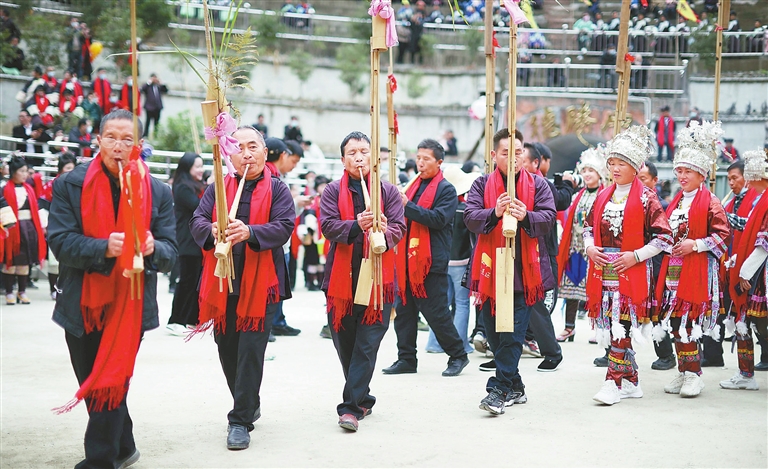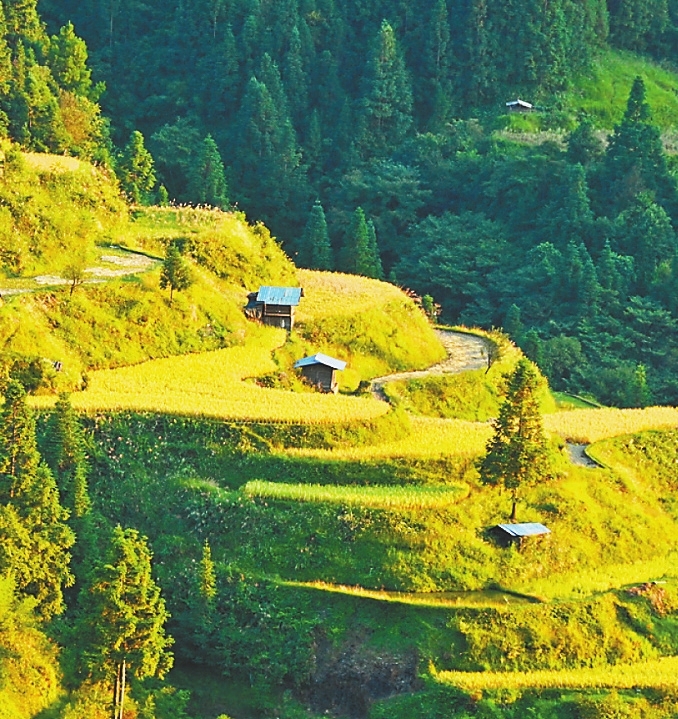





THE mountain ranges of southeast Guizhou in Southwest China have nurtured many ethnic groups. In the primitive villages, people have established unique cultures and traditions and learned crafts from their ancestors. Join us today to explore the villages and learn about the rich, myriad cultures that flourish in the mountains. Batik Jijia Village of Danzhai County is a traditional settlement of the Miao ethnic group. Hidden amid mountain ranges, the village has well preserved its traditional customs and crafts. Danzhai batik, a wax-resist dyeing technique that has a long history among Miao people, is one of them. Danzhai batik is made by using a ladao — a pen-like copper tool — to draw patterns on the cloth with wax. For a medium-sized batik work, the painting process takes a few weeks, and an experienced artisan can draw beautiful lines without the help of other tools. Painted cloths are then rolled up, threaded together, and hung on a wooden shelf before they’re soaked in dyes made of indigo paste, water and rice wine. This process generally takes two to three days, during which the cloths are repeatedly lifted out of the dye vat for oxidation and then put back into the vat again. Each oxidation process takes around 30 minutes for the cloth to get a darker blue color. To get an indigo cloth, the process should be repeated dozens of times. According to the locals, the dye vat should be maintained, or in their words, “nurtured,” properly and frequently, or else, it will simply “die out,” meaning it can no longer be used. After the dyeing process is completed, the cloths are then boiled repeatedly to remove the wax; when completed, beautiful white patterns will be revealed on the indigo batik. Golden pheasant dance Maniao Village in Danzhai County is another distant village hidden in the high mountains. Known for its golden pheasant dance, a traditional dance often performed at festivals and on worshipping rituals, the village is named after the dance because “maniao” refers to the golden pheasant in the Miao language. On the special days, girls and women will put on costumes mimicking golden pheasants, line up after a man playing lusheng (a reed-pipe wind instrument), and dance in counterclockwise circles. When they move, the golden pheasant silver decorations on their heads glitter, the colorful strips of their skirts flutter, and the white feathers hemming their skirts flicker. The lusheng music of Maniao Village, which leads the golden pheasant dance, is as well-known as the dance. The Miao music instrument has a delightful sound and a wide range of keys; locals have a repertoire of more than 100 traditional music pieces. Living high on the mountain, the villagers have built terraced paddy fields along the mountains and keep fish in the fields. A fun sport for visitors is to try catching fish with the help of the locals. To catch a fish, one needs to catch locusts as bait. Once the fish show themselves, you can use a bamboo basket to capture them. Folk songs of the Dong ethnic group Located in Liping County, Liufang Village is home to 183 households of the Dong people. Like other ethnic groups, weddings are an important part of the local culture, and a traditional Dong wedding often involves singing. A wedding in the village often starts in the morning when the bridegroom’s families and friends escort him to the bride’s home; the procession will bring with them suckling pigs and grains as gifts. To enter the bride’s home, they need to impress her family members and friends in a kind of folk singing competition. Nai Jianyun, a woman of Dong ethnic group, is a musician of the village. She sings all the time, for example, when she is taking a stroll in the fields or having a gathering with friends at home. Her songs range from traditional folk music of the Dong ethnic group to impromptu songs she creates. Wooden stilt houses are a traditional architectural form in Liufang Village. They are not only dwellings for the villagers, but also places to store their grains. Stilted barns in the village are built above water. They’re fire-proof with good ventilation. Below the barn, people raise fish and ducks, and keep coffins of the deceased as they consider the space to be a location with good fengshui (literally, wind and water, referring to the natural elements that will influence one’s fortune). In addition to the stilted houses, a 600-year-old drum tower and a 200-year-old stone path are also worth visiting. The drum tower stands at the center of the village. The stone path winds through paddy fields and forests all the way to the other side of the mountain. Following the path, visitors can enjoy a panoramic view of the serene village. (Lin Lin) | 
